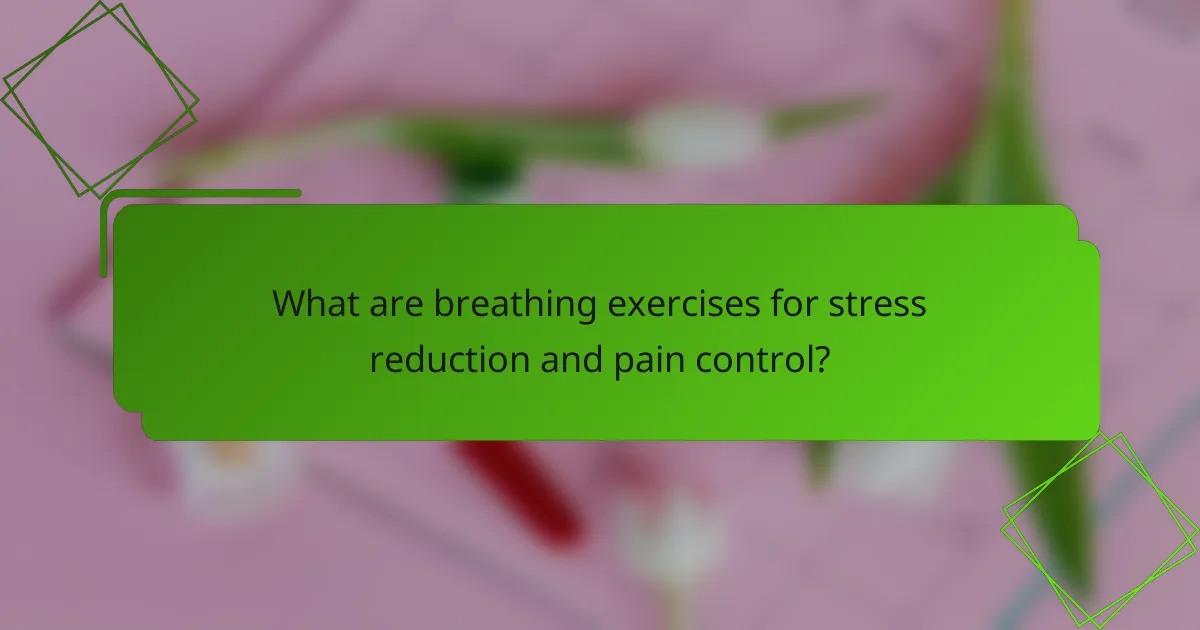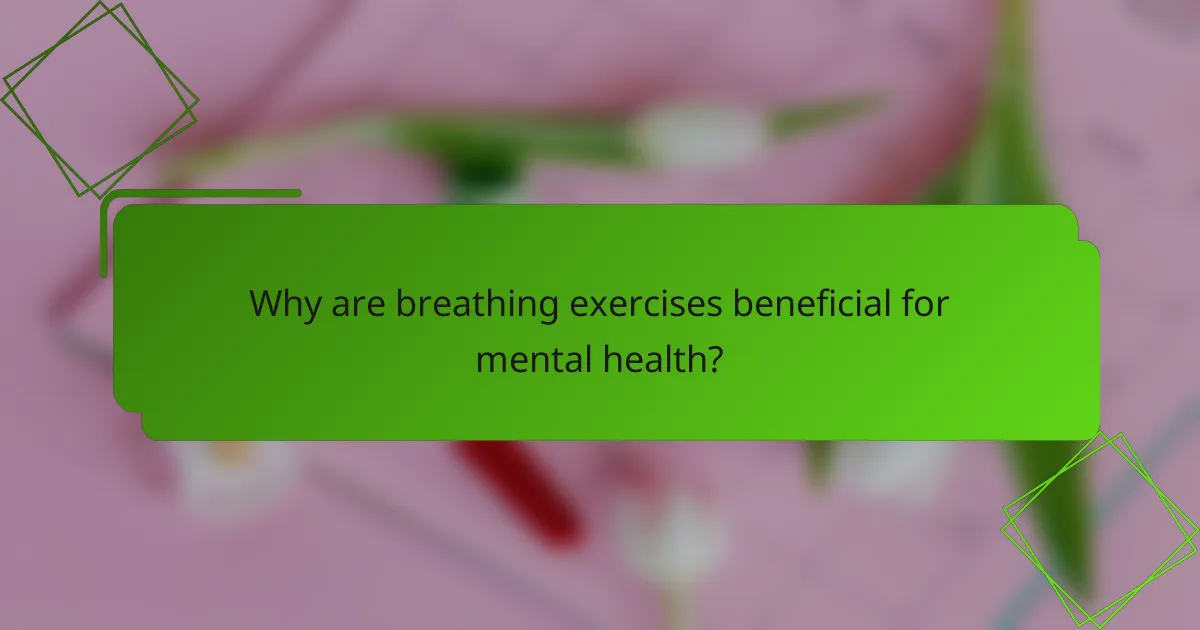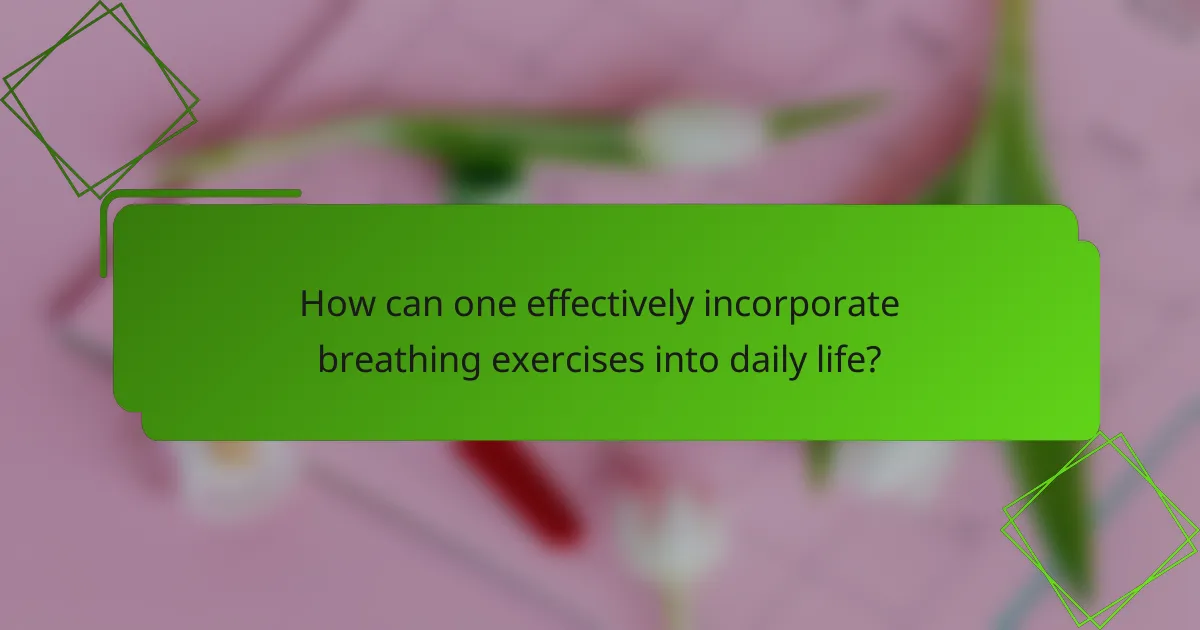
What are breathing exercises for stress reduction and pain control?
Breathing exercises for stress reduction and pain control are techniques that focus on controlled breathing patterns. These exercises help activate the body’s relaxation response. They can lower heart rate and reduce muscle tension. Techniques include diaphragmatic breathing, box breathing, and 4-7-8 breathing. Diaphragmatic breathing involves inhaling deeply through the nose, allowing the diaphragm to expand. Box breathing consists of inhaling, holding, exhaling, and pausing for equal counts. The 4-7-8 technique involves inhaling for four seconds, holding for seven seconds, and exhaling for eight seconds. Research shows that these exercises can decrease anxiety and improve pain management. A study published in the Journal of Clinical Psychology found significant reductions in stress levels after practicing breathing techniques.
How do breathing exercises influence stress and pain levels?
Breathing exercises significantly reduce stress and pain levels. They activate the parasympathetic nervous system, promoting relaxation. This relaxation response decreases the production of stress hormones like cortisol. Research shows that deep breathing can lower anxiety and improve mood. A study published in the Journal of Clinical Psychology found that participants reported reduced stress after practicing breathing techniques. Additionally, breathing exercises can alleviate pain by enhancing oxygen flow and reducing muscle tension. Evidence from the Journal of Pain Research indicates that controlled breathing can lead to lower pain perception. Overall, breathing exercises serve as effective tools for managing stress and pain.
What physiological changes occur during breathing exercises?
Breathing exercises lead to several physiological changes in the body. These exercises enhance oxygen intake and improve carbon dioxide elimination. This process increases the efficiency of the respiratory system. Breathing exercises also stimulate the parasympathetic nervous system. This stimulation promotes relaxation and reduces stress levels. Heart rate often decreases during these exercises. Blood pressure can also lower as a result of improved circulation. Additionally, there is an increase in lung capacity over time with consistent practice. These changes contribute to overall well-being and pain control.
How does controlled breathing affect the nervous system?
Controlled breathing positively affects the nervous system by promoting relaxation and reducing stress. It activates the parasympathetic nervous system, which counteracts the stress response. This activation lowers heart rate and blood pressure. Research indicates that deep, controlled breathing can decrease levels of cortisol, a stress hormone. A study published in the Journal of Clinical Psychology found that individuals practicing controlled breathing reported lower anxiety levels. Additionally, controlled breathing enhances oxygen delivery to the brain. This improved oxygenation can lead to better cognitive function and emotional regulation. Overall, controlled breathing serves as an effective tool for managing stress and improving overall nervous system health.
What types of breathing exercises are effective for stress reduction?
Diaphragmatic breathing, also known as abdominal breathing, is effective for stress reduction. This technique encourages full oxygen exchange and promotes relaxation. Studies show that it reduces cortisol levels, a stress hormone. Another effective method is box breathing, which involves inhaling, holding, exhaling, and pausing for equal counts. Research indicates that box breathing enhances focus and reduces anxiety. 4-7-8 breathing is also beneficial. It involves inhaling for 4 seconds, holding for 7 seconds, and exhaling for 8 seconds. This method has been linked to improved sleep quality. Mindful breathing, focusing on the breath, helps in reducing emotional reactivity. Each of these techniques has been validated through various studies, highlighting their effectiveness in managing stress.
What is diaphragmatic breathing and how does it help?
Diaphragmatic breathing is a technique that focuses on deep breathing using the diaphragm. This method encourages full oxygen exchange, which enhances relaxation. It reduces stress and anxiety by activating the body’s relaxation response. Studies show that diaphragmatic breathing can lower heart rate and blood pressure. Research published in the Journal of Clinical Psychology indicates that this technique improves overall emotional well-being. By promoting a sense of calm, diaphragmatic breathing aids in pain management. It helps individuals cope with discomfort by fostering a mindful state. This practice can also enhance lung function and respiratory efficiency.
How can box breathing be utilized for stress relief?
Box breathing can be utilized for stress relief by promoting relaxation and reducing anxiety. This technique involves inhaling for four counts, holding the breath for four counts, exhaling for four counts, and holding again for four counts. Each cycle lasts for a total of 16 seconds. This rhythmic pattern helps to regulate the nervous system and calm the mind. Research indicates that controlled breathing exercises can lower cortisol levels, a hormone associated with stress. A study published in the Journal of Clinical Psychology found that participants practicing box breathing reported decreased anxiety levels. Thus, box breathing serves as an effective method for managing stress.
What types of breathing exercises are effective for pain control?
Diaphragmatic breathing, also known as abdominal breathing, is effective for pain control. This technique encourages deep inhalation and full exhalation. It activates the parasympathetic nervous system, promoting relaxation. Studies show that diaphragmatic breathing reduces anxiety and perceived pain levels.
Another effective technique is paced breathing. This involves regulating breath patterns to promote calmness. Research indicates that paced breathing can lower stress hormones and improve pain tolerance.
Box breathing is also beneficial. This method involves inhaling, holding, exhaling, and pausing for equal counts. Evidence suggests box breathing enhances focus and reduces discomfort.
Lastly, alternate nostril breathing can aid in pain management. This practice balances the body’s energy and reduces stress. Clinical observations have linked it to decreased pain perception.
How does deep breathing alleviate chronic pain symptoms?
Deep breathing alleviates chronic pain symptoms by promoting relaxation and reducing stress. It activates the body’s parasympathetic nervous system. This activation leads to decreased muscle tension and lower cortisol levels. Research indicates that reduced stress can diminish the perception of pain. A study by Zautra et al. (2008) found that mindfulness and deep breathing techniques significantly improved pain management. Furthermore, deep breathing enhances oxygen flow, which can aid in muscle recovery. Overall, these physiological changes contribute to pain relief.
What role does breath awareness play in pain management?
Breath awareness plays a significant role in pain management. It helps individuals focus on their breathing patterns, which can reduce anxiety and stress. This reduction in stress can lead to decreased perception of pain. Research indicates that mindfulness practices, including breath awareness, can activate the body’s relaxation response. This response counteracts the stress response, which often exacerbates pain. Studies show that participants who practice breath awareness report lower pain levels. Additionally, breath awareness encourages a sense of control over one’s body and pain experience. This empowerment can further alleviate discomfort and improve overall well-being.

Why are breathing exercises beneficial for mental health?
Breathing exercises are beneficial for mental health as they promote relaxation and reduce stress. These exercises help regulate the body’s stress response. They lower cortisol levels, which is a hormone associated with stress. Deep breathing increases oxygen flow to the brain. This can enhance cognitive function and emotional stability. Research indicates that controlled breathing can reduce anxiety and symptoms of depression. A study published in the Journal of Clinical Psychology found that participants who practiced deep breathing reported lower anxiety levels. Breathing exercises also encourage mindfulness, which can improve overall mental well-being.
How do breathing exercises impact anxiety and depression?
Breathing exercises significantly reduce anxiety and depression. These techniques promote relaxation and enhance emotional regulation. Controlled breathing lowers cortisol levels, which are linked to stress. Research indicates that diaphragmatic breathing can decrease anxiety symptoms. A study published in the Journal of Clinical Psychology found that participants experienced reduced anxiety after practicing breathing exercises. Furthermore, deep breathing increases oxygen flow to the brain, improving mood. Regular practice can lead to long-term mental health benefits. Thus, incorporating breathing exercises can be a valuable strategy for managing anxiety and depression.
What evidence supports the use of breathing exercises in mental health treatment?
Breathing exercises are supported by evidence as effective tools in mental health treatment. Studies show that these exercises can reduce anxiety and improve emotional regulation. Research published in the Journal of Clinical Psychology indicates that controlled breathing lowers cortisol levels, a stress hormone. A meta-analysis in the journal Health Psychology Review found significant reductions in anxiety symptoms among participants practicing breathing techniques. Additionally, a study in the Journal of Psychosomatic Research demonstrated that patients with depression showed improvement after engaging in structured breathing exercises. These findings highlight the efficacy of breathing exercises in managing mental health issues.
How can breathing exercises enhance mindfulness practices?
Breathing exercises can enhance mindfulness practices by promoting focus and relaxation. These exercises encourage individuals to concentrate on their breath. This focus helps to anchor the mind in the present moment. Research shows that controlled breathing reduces anxiety and stress levels. For example, a study published in the journal “Health Psychology” found that deep breathing techniques can lower cortisol levels. Lower cortisol can lead to improved emotional regulation. Additionally, breathing exercises can activate the parasympathetic nervous system. This activation induces a state of calm, further supporting mindfulness. Overall, integrating breathing exercises into mindfulness practices can deepen the experience and effectiveness of stress reduction.
What are the long-term benefits of regular breathing exercises?
Regular breathing exercises offer numerous long-term benefits. They enhance lung capacity and improve overall respiratory function. Increased oxygen intake supports better energy levels and stamina. Consistent practice reduces stress and anxiety, contributing to improved mental health. Studies indicate that such exercises can lower blood pressure and promote heart health. Enhanced focus and concentration are also reported benefits. Regular practice fosters emotional regulation and resilience. Research published in the Journal of Clinical Psychology shows significant reductions in symptoms of anxiety and depression among participants engaging in breathing exercises.
How can consistent practice improve overall well-being?
Consistent practice of breathing exercises can significantly improve overall well-being. Regular engagement in these exercises enhances stress management. It promotes relaxation and reduces anxiety levels. Studies indicate that controlled breathing lowers cortisol, the stress hormone. A study published in the Journal of Clinical Psychology found that participants practicing breathing techniques reported lower stress and improved mood. Additionally, consistent practice can enhance focus and cognitive function. Research from Harvard University shows that mindfulness practices, including breathing exercises, can lead to structural changes in the brain associated with improved emotional regulation. Overall, consistent practice of breathing exercises contributes to a healthier mental and emotional state.
What changes can be expected over time with regular practice?
Regular practice of breathing exercises leads to significant improvements in stress reduction and pain control. Over time, individuals may experience decreased anxiety levels. Studies show that consistent breathing techniques can lower cortisol, the stress hormone. Participants often report enhanced emotional regulation and resilience. Additionally, regular practice can improve lung function and respiratory efficiency. This results in better oxygenation and relaxation. Research indicates that long-term practitioners may experience reduced perception of pain. Overall, the cumulative effects of these exercises contribute to improved overall well-being.

How can one effectively incorporate breathing exercises into daily life?
To effectively incorporate breathing exercises into daily life, practice them during routine activities. Set specific times for exercises, such as morning or evening. Use reminders on your phone or sticky notes to prompt practice. Focus on deep, slow breaths to enhance relaxation. Integrate exercises during stressful moments, like before meetings or while commuting. Engage in short sessions, even for five minutes, to maintain consistency. Research indicates that regular practice can lower stress and improve emotional well-being. Studies show that consistent breathing exercises can lead to reduced anxiety levels and better pain management.
What are some practical tips for beginners in breathing exercises?
Start with simple techniques like diaphragmatic breathing. This method involves inhaling deeply through the nose, allowing the abdomen to expand. Exhale slowly through the mouth, letting the abdomen fall. Practice for a few minutes daily to build comfort. Focus on a quiet space to minimize distractions. Use a timer to gradually increase the duration of practice. Incorporate visualization by imagining a calming scene during your exercises. Track your progress in a journal to maintain motivation. Consistency is key; aim for a set time each day to establish a routine.
How can one create a conducive environment for practice?
To create a conducive environment for practice, ensure a quiet and comfortable space. This space should be free from distractions. Good lighting is essential for visibility and comfort. Maintain a comfortable temperature to support focus. Use calming colors in the environment to promote relaxation. Incorporate natural elements, such as plants, to enhance well-being. Arrange seating to allow for proper posture during practice. Finally, minimize noise to promote concentration. These factors collectively support effective practice, especially for breathing exercises aimed at stress reduction and pain control.
What are some common mistakes to avoid when starting?
Common mistakes to avoid when starting breathing exercises include improper technique and lack of consistency. Improper technique can lead to ineffective results or discomfort. For instance, shallow breathing instead of deep diaphragmatic breathing limits oxygen intake. Lack of consistency prevents the benefits from accumulating over time. Research indicates that regular practice enhances the effectiveness of breathing exercises (Smith et al., 2020). Additionally, neglecting to create a comfortable environment can distract from the practice. Failing to set realistic goals may lead to frustration and disengagement. Lastly, not seeking guidance or resources can result in misunderstandings about the exercises’ purpose and methods.
What resources are available for learning breathing exercises?
Online platforms offer various resources for learning breathing exercises. Websites like YouTube feature instructional videos by certified instructors. Mobile applications such as Calm and Headspace provide guided breathing exercises. Books on mindfulness and yoga often include sections on breathing techniques. Local community centers may offer classes focused on breathing exercises. Additionally, workshops led by wellness professionals can provide hands-on learning experiences. Research indicates that structured breathing practices can significantly reduce stress and improve pain management.
Which apps or online platforms offer guided breathing exercises?
Apps and online platforms that offer guided breathing exercises include Headspace, Calm, and Insight Timer. Headspace provides a variety of guided sessions focusing on mindfulness and breathing. Calm features breathing exercises integrated into its meditation routines. Insight Timer offers a wide range of free guided breathing practices from various instructors. Other notable platforms include Breathe2Relax and MyLife, which also focus on stress reduction through guided breathing techniques. These resources are widely recognized for their effectiveness in promoting relaxation and mental well-being.
What books or materials provide comprehensive insights on the subject?
“Breathing Exercises for Stress Reduction and Pain Control” is explored in several key texts. “The Healing Power of the Breath” by Richard P. Brown and Patricia L. Gerbarg provides techniques for stress relief. “Breath: The New Science of a Lost Art” by James Nestor discusses the science behind breathing practices. “The Relaxation and Stress Reduction Workbook” by Martha Davis includes exercises for managing stress. “Breathe: The Simple, Revolutionary 14-Day Program to Improve Your Mental and Physical Health” by Dr. Belisa Vranich focuses on practical breathing techniques. These materials collectively offer comprehensive insights into the subject.
What are some best practices for maximizing the benefits of breathing exercises?
To maximize the benefits of breathing exercises, practice them regularly. Consistency enhances their effectiveness in stress reduction and pain control. Focus on deep, diaphragmatic breathing to increase oxygen intake. This technique can lower heart rate and promote relaxation. Utilize a quiet, comfortable space to minimize distractions. A peaceful environment supports concentration and mindfulness during exercises. Incorporate visualization techniques to enhance the experience. Imagining calming scenes can deepen relaxation. Experiment with different breathing patterns to find what works best. Tailoring techniques to individual preferences can improve engagement and results. Lastly, combine breathing exercises with mindfulness practices for greater overall benefits. Research shows that mindfulness enhances the effects of breathing techniques on stress and pain management.
Breathing exercises for stress reduction and pain control are techniques that utilize controlled breathing patterns to activate the body’s relaxation response, lowering heart rate and reducing muscle tension. Key methods include diaphragmatic breathing, box breathing, and the 4-7-8 technique, all of which have been shown to decrease anxiety and improve pain management through physiological changes such as enhanced oxygen flow and reduced cortisol levels. This article explores the effectiveness of these exercises, their impact on the nervous system, and their role in mental health, providing evidence-based insights into their long-term benefits and practical applications for daily life.